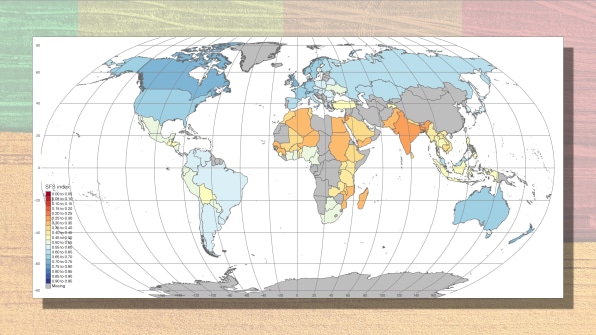
Food systems are going to need to be resilient to withstand climate change’s effects on agriculture. Looking at 20 factors, researchers now have a big picture about which countries are most under threat.
What we choose to eat can affect climate change, and that means all the factors involved in feeding our growing population—from agriculture to fair trade to food waste to the labor force—can have an impact on how sustainable our food system is. That’s a lot of information to track, but it’s important to have that big-picture perspective. And now we’re closer to it, thanks to a map created by the International Center for Tropical Agriculture (CIAT) that rates food sustainability for different countries around the world.
The map is less about ranking the “most” and “least” sustainable food systems, says Steven Prager, coauthor of the paper on the map published in Nature and a senior scientist at the research nonprofit CIAT. It’s more about allowing, finally, for a broad look at food systems around the world so we can compare what different countries are doing, and understand how all the facets of food sustainability are connected to inform the best policy decisions.
The term “food system” refers to the entire web of food production and consumption from beginning to end, from growing and harvesting to processing and packaging, from transportation and consumption to the disposal of food waste. And though this research is meant more to influence policy and track changes in food system sustainability over time, there are a few takeaways about the world’s food systems that just looking at the map can tell us. First, says Prager, the image has made it clear that there is a North versus South dynamic, showing that Northern countries currently have much more sustainable food systems than those in the South (on the map, the scale goes from blue to red, with blue showing high sustainability; gray means there is not enough data).
That relates to his second big point: that there clearly won’t be a “one size fits all” solution to creating sustainable food systems of the future because of how much variety there currently is. Even among countries that have been comparedfor their growing economies, like Brazil, Russia, and India, the levels of sustainability vary, and so a solution for one country to raise its sustainability metric may not be what another needs to maintain its level.
I do not even know how I ended up here, but I thought this post was great. I don’t know who you are but definitely you are going to a famous blogger if you are not already 😉 Cheers!
HI. I am glad you enjoyed the posts!
An fascinating dialogue is value comment. I think that it’s best to write extra on this matter, it won’t be a taboo topic however usually people are not sufficient to talk on such topics. To the next. Cheers
With havin so much written content do you ever run into any issues of plagorism or copyright infringement? My blog has a lot of unique content I’ve either created myself or outsourced but it appears a lot of it is popping it up all over the internet without my agreement. Do you know any solutions to help stop content from being ripped off? I’d truly appreciate it.
Comments are closed.